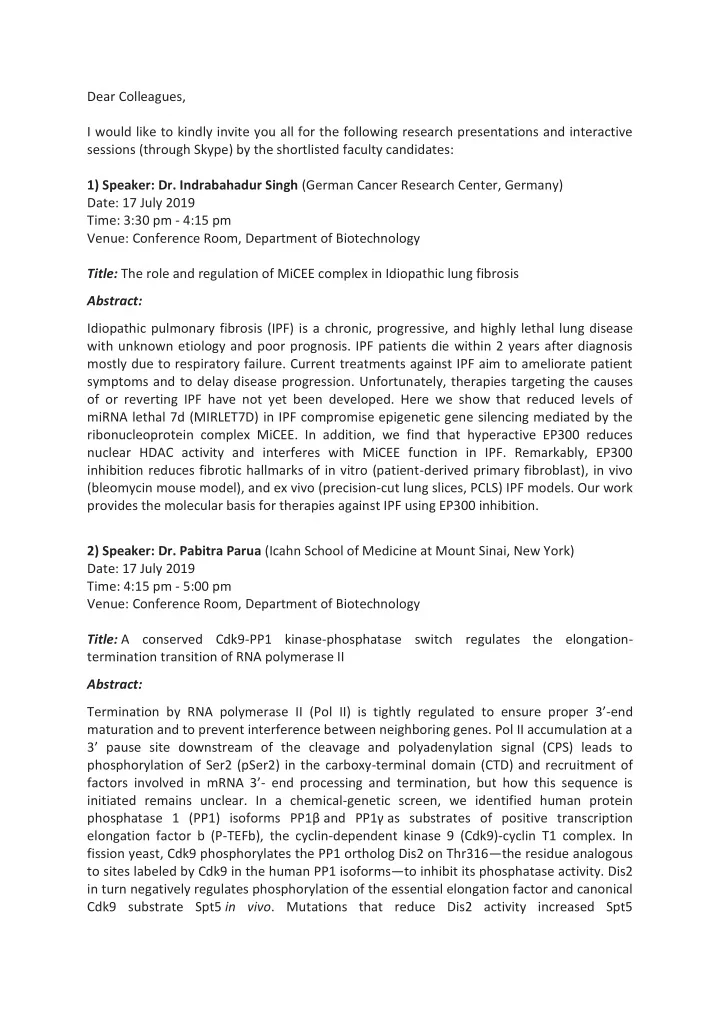

Dear Colleagues, I would like to kindly invite you all for the following research presentations and interactive sessions (through Skype) by the shortlisted faculty candidates: 1) Speaker: Dr. Indrabahadur Singh (German Cancer Research Center, Germany) Date: 17 July 2019 Time: 3:30 pm - 4:15 pm Venue: Conference Room, Department of Biotechnology Title: The role and regulation of MiCEE complex in Idiopathic lung fibrosis Abstract: Idiopathic pulmonary fibrosis (IPF) is a chronic, progressive, and highly lethal lung disease with unknown etiology and poor prognosis. IPF patients die within 2 years after diagnosis mostly due to respiratory failure. Current treatments against IPF aim to ameliorate patient symptoms and to delay disease progression. Unfortunately, therapies targeting the causes of or reverting IPF have not yet been developed. Here we show that reduced levels of miRNA lethal 7d (MIRLET7D) in IPF compromise epigenetic gene silencing mediated by the ribonucleoprotein complex MiCEE. In addition, we find that hyperactive EP300 reduces nuclear HDAC activity and interferes with MiCEE function in IPF. Remarkably, EP300 inhibition reduces fibrotic hallmarks of in vitro (patient-derived primary fibroblast), in vivo (bleomycin mouse model), and ex vivo (precision-cut lung slices, PCLS) IPF models. Our work provides the molecular basis for therapies against IPF using EP300 inhibition. 2) Speaker: Dr. Pabitra Parua (Icahn School of Medicine at Mount Sinai, New York) Date: 17 July 2019 Time: 4:15 pm - 5:00 pm Venue: Conference Room, Department of Biotechnology Title: A conserved Cdk9-PP1 kinase-phosphatase switch regulates the elongation- termination transition of RNA polymerase II Abstract: Termination by RNA polymerase II (Pol II) is tightly regulate d to ensure proper 3’ -end maturation and to prevent interference between neighboring genes. Pol II accumulation at a 3’ pause site downstream of the cleavage and polyadenylation signal (CPS) leads to phosphorylation of Ser2 (pSer2) in the carboxy-terminal domain (CTD) and recruitment of factors involved in mRNA 3’ - end processing and termination, but how this sequence is initiated remains unclear. In a chemical-genetic screen, we identified human protein phosphatase 1 (PP1) isoforms PP1β and PP1γ as substrates of positive transcription elongation factor b (P-TEFb), the cyclin-dependent kinase 9 (Cdk9)-cyclin T1 complex. In fission yeast, Cdk9 phosphorylates the PP1 ortholog Dis2 on Thr316 — the residue analogous to sites labeled by Cdk9 in the human PP1 isoforms — to inhibit its phosphatase activity. Dis2 in turn negatively regulates phosphorylation of the essential elongation factor and canonical Cdk9 substrate Spt5 in vivo . Mutations that reduce Dis2 activity increased Spt5
phosphorylation on chromatin, most markedly downstream of the CPS, and decreased termination efficiency measured by precision run-on transcription and sequencing (PRO- seq) analysis. These results support a model in which a bistable Cdk9-PP1 switch regulates the transition of Pol II from elongation to termination; an analogous switch comprising Dis2 and the major cell-cycle CDK, Cdk1, controls progression through mitosis. This mechanism appears to be conserved in human cells, by the following criteria: 1) by chromatin immunoprecipitation and sequencing (ChIP-seq) analysis, phosphorylation of human Spt5 on a carboxy-terminal site (Thr806) dropped sharply downstream of the CPS, concomitant with 3’ - pausing of Pol II; 2) chemical inhibition or RNAi-mediated depletion of PP1 increased Spt5- Thr806 phosphorylation; and 3) inhibition of Cdk9 diminished phosphorylation of PP1γ -Thr311 in vivo . In both yeast and human cells, ChIP-seq analysis revealed a reciprocal relationship between Spt5 carboxy-terminal phosphorylation and pSer2, which decrease and incr ease, respectively, downstream of the CPS, where Pol II accumulates at the 3’ pause site. Therefore, the CDK-PP1 switch is a common regulatory module governing mitotic and transcriptional exit, which is likely to be conserved between fission yeast and humans. 3) Speaker: Dr. Rishikesh Pandey (CytoVeris Inc., USA) Date: 17 July 2019 Time: 5:00 pm - 5:45 pm Venue: Conference Room, Department of Biotechnology Title (tentative): Biomedical Imaging and Biophotonics Abstract (tentative): My research work centers on the development and deployment of novel biophotonics technologies that interface and bridge Raman spectroscopy, cancer diagnosis, and label-free imaging. Specifically, I seek to employ vibrational spectroscopic and imaging techniques to obtain biomolecular signatures that can reveal latent information on pathological conditions. As a faculty member, I developed a unified imaging platform comprising Raman and transmission quantitative phase microscopy to study both biophysical and biochemical characteristics of live cells in their actual physiological condition. One of the focal points of my current research is in the area of breast cancer where we are developing a Raman spectroscopy-based tool for intra-operative precision margin assessment. Recently, we have demonstrated the applicability of our diffraction phase microscopy in discerning real-time morphological changes associated with T cell activation without necessitating any contrast agent. Using deep learning formalism on the acquired quantitative phase images, we were able to accurately predict the population ratios of the unknown mixed population of naïve and activated cells. Regards Dr. Deepak Sharma Assistant Professor Department of Biotechnology Indian Institute of Technology Roorkee (IIT-R) Roorkee - 247667, Uttarakhand, India Ph. +91-1332-284827
Recommend
More recommend